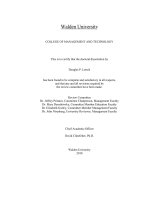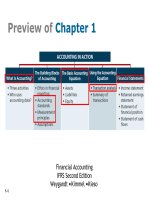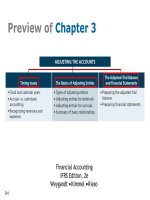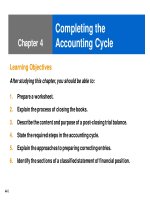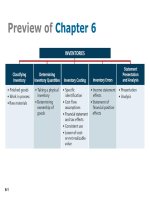Financial accounting chapter 09 plant assets, natural resources, and intangible assets
Bạn đang xem bản rút gọn của tài liệu. Xem và tải ngay bản đầy đủ của tài liệu tại đây (709.79 KB, 53 trang )
9-1
Chapter 9
Plant Assets, Natural
Resources, and Intangible
Assets
Learning Objectives
After studying this chapter, you should be able to:
1. Describe how the historical cost principle applies to plant assets.
2. Explain the concept of depreciation and how to compute it.
3. Distinguish between revenue and capital expenditures, and explain the
entries for each.
4. Explain how to account for the disposal of a plant asset.
5. Compute periodic depletion of extractable natural resources.
6. Explain the basic issues related to accounting for intangible assets.
7. Indicate how plant assets, natural resources, and intangible assets are
reported.
9-2
Plant assets are resources that have
physical substance (a definite size and shape),
are used in the operations of a business,
are not intended for sale to customers,
are expected to provide service to the company for a
number of years.
Referred to as property, plant, and equipment; plant and
equipment; and fixed assets.
Plant Assets
9-3
Illustration 9-1
Plant Assets
Plant assets are critical to a company’s success.
9-4
In general, companies record plant assets at cost.
LO 1 Describe how the cost principle applies to plant assets.
Determining the Cost of Plant Assets
Cost consists of all expenditures necessary to
acquire an asset and make it ready for its
intended use.
9-5
All necessary costs incurred in making land ready for its
intended use increase (debit) the Land account.
Costs typically include:
1) cash purchase price,
2) closing costs such as title and attorney’s fees,
3) real estate brokers’ commissions,
4) accrued property taxes and other liens assumed by the
purchaser, and
5) clearing, leveling, demo of existing structures.
LO 1 Describe how the cost principle applies to plant assets.
Determining the Cost of Plant Assets
Land
9-6
Illustration: Lew Company acquires real estate at a cash cost
of HK$2,000,000. The property contains an old warehouse that
is razed at a net cost of HK$60,000 (HK$75,000 in costs less
HK$15,000 proceeds from salvaged materials). Additional
expenditures are the attorney’s fee, HK$10,000, and the real
estate broker’s commission, HK$80,000.
Required: Determine the amount to be reported as the cost of
the land.
LO 1 Describe how the cost principle applies to plant assets.
Determining the Cost of Plant Assets
9-7
Land
Required: Determine amount to be reported as the cost of the
land.
LO 1 Describe how the cost principle applies to plant assets.
Cash price of property (HK$2,000,000)
Net removal cost of warehouse (HK$60,000)
Attorney's fees (HK$10,000) 10,000
60,000
HK$2,000,000
HK$2,150,000Cost of Land
Real estate broker’s commission (HK$80,000) 80,000
Determining the Cost of Plant Assets
9-8
Includes all expenditures necessary to make the
improvements ready for their intended use.
Land Improvements
Examples: driveways, parking lots, fences, landscaping,
and lighting.
Limited useful lives.
Expense (depreciate) the cost of land improvements over
their useful lives.
LO 1 Describe how the cost principle applies to plant assets.
Determining the Cost of Plant Assets
9-9
Includes all costs related directly to purchase or construction.
Purchase costs:
Purchase price, closing costs (attorney’s fees, title insurance,
etc.) and real estate broker’s commission.
Remodeling and replacing or repairing the roof, floors,
electrical wiring, and plumbing.
Construction costs:
Contract price plus payments for architects’ fees, building
permits, and excavation costs.
LO 1 Describe how the cost principle applies to plant assets.
Determining the Cost of Plant Assets
Buildings
9-10
Include all costs incurred in acquiring the equipment and
preparing it for use.
Costs typically include:
Cash purchase price.
Sales taxes.
Freight charges.
Insurance during transit paid by the purchaser.
Expenditures required in assembling, installing, and testing
the unit.
LO 1 Describe how the cost principle applies to plant assets.
Determining the Cost of Plant Assets
Equipment
9-11
Illustration: Zhang Company purchases factory machinery at
a cash price of HK$500,000. Related expenditures are for
sales taxes HK$30,000, insurance during shipping HK$5,000,
and installation and testing HK$10,000. Compute the cost of
the machinery.
LO 1 Describe how the cost principle applies to plant assets.
Machinery
Cash price
Sales taxes
Insurance during shipping 5,000
30,000
HK$500,000
HK$545,000Cost of Machinery
Determining the Cost of Plant Assets
Installation and testing 10,000
9-12
Cash 545,000
LO 1 Describe how the cost principle applies to plant assets.
Equipment 545,000
Determining the Cost of Plant Assets
Illustration: Zhang Company purchases factory machinery at
a cash price of HK$500,000. Related expenditures are for sales
taxes HK$30,000, insurance during shipping HK$5,000, and
installation and testing HK$10,000. Prepare the journal entry to
record these costs.
9-13
Illustration: Huang Company purchases a delivery truck at a
cash price of HK$420,000. Related expenditures are sales taxes
HK$13,200, painting and lettering HK$5,000, motor vehicle
license HK$800, and a three-year accident insurance policy
HK$16,000. Compute the cost of the delivery truck.
LO 1 Describe how the cost principle applies to plant assets.
Truck
Cash price
Sales taxes
Painting and lettering 5,000
13,200
HK$420,000
HK$438,200Cost of Delivery Truck
Determining the Cost of Plant Assets
9-14
Illustration: Huang Company purchases a delivery truck at a
cash price of HK$420,000. Related expenditures are sales taxes
HK$13,200, painting and lettering HK$5,000, motor vehicle
license HK$800, and a three-year accident insurance policy
HK$16,000. Prepare the journal entry to record these costs.
LO 1 Describe how the cost principle applies to plant assets.
Equipment 438,200
License expense 800
Prepaid insurance 16,000
Cash 455,000
Determining the Cost of Plant Assets
9-15
Process of cost allocation, not asset valuation.
Applies to land improvements, buildings, and
equipment, not land.
Depreciable, because the revenue-producing ability
of asset will decline over the asset’s useful life.
Process of allocating to expense the cost of a plant asset
over its useful (service) life in a rational and systematic
manner.
LO 2 Explain the concept of depreciation and how to compute it.
Depreciation
Depreciation
9-16
Cost Useful Life Residual Value
Illustration 9-6
Depreciation
Factors in Computing Depreciation
LO 2 Explain the concept of depreciation and how to compute it.
9-17
Management selects the method it believes best measures an
asset’s contribution to revenue over its useful life.
Examples include:
(1) Straight-line method
(2) Units-of-activity method
(3) Declining-balance method
Depreciation
Depreciation Methods
LO 2 Explain the concept of depreciation and how to compute it.
9-18
Illustration: Barb’s Florists purchased a small delivery truck on
January 1, 2014.
Required: Compute depreciation using the following.
(a) Straight-Line. (b) Units-of-Activity. (c) Declining Balance.
Depreciation
Illustration 9-7
LO 2 Explain the concept of depreciation and how to compute it.
9-19
Straight-Line
Expense is same amount for each year.
Depreciable cost = Cost less residual value.
Illustration 9-8
Depreciation
LO 2 Explain the concept of depreciation and how to compute it.
9-20
Illustration: (Straight-Line Method)
2014 € 12,000 20% € 2,400 € 2,400 € 10,600
2015 12,000 20 2,400 4,800 8,200
2016 12,000 20 2,400 7,200 5,800
2017 12,000 20 2,400 9,600 3,400
2018 12,000 20 2,400 12,000 1,000
2014
Journal
Entry
Depreciation expense 2,400
Accumulated depreciation 2,400
Illustration 9-10
Depreciation
LO 2 Explain the concept of depreciation and how to compute it.
9-21
Assume the delivery truck was purchased on April 1, 2014.
Depreciation
Partial
Year
Illustration: (Straight-Line Method)
LO 2
9-22
Companies estimate total units of activity to calculate
depreciation cost per unit.
Units-of-Activity
Illustration 9-10
Expense varies based
on units of activity.
Depreciable cost is
cost less residual
value.
Depreciation
LO 2 Explain the concept of depreciation and how to compute it.
9-23
Illustration: (Units-of-Activity Method)
2014 15,000 € 0.12 € 1,800 € 1,800 € 11,200
2015 30,000 0.12 3,600 5,400 7,600
2016 20,000 0.12 2,400 7,800 5,200
2017 25,000 0.12 3,000 10,800 2,200
2018 10,000 0.12 1,200 12,000 1,000
Depreciation expense 1,800
Accumulated depreciation 1,800
2014
Journal
Entry
Illustration 9-11
Depreciation
LO 2 Explain the concept of depreciation and how to compute it.
9-24
Declining-Balance
Accelerated method.
Decreasing annual depreciation expense over the asset’s
useful life.
Twice the straight-line rate with Double-Declining-Balance.
Rate applied to book value.
Depreciation
Illustration 9-12
LO 2 Explain the concept of depreciation and how to compute it.
9-25
Illustration: (Declining-Balance Method)
2014 € 13,000 40% € 5,200 € 5,200 € 7,800
2015 7,800 40 3,120 8,320 4,680
2016 4,680 40 1,872 10,192 2,808
2017 2,808 40 1,123 11,315 1,685
2018 1,685 40 685* 12,000 1,000
* Computation of $674 ($1,685 x 40%) is adjusted to $685.
Depreciation expense 5,200
Accumulated depreciation 5,200
2014
Journal
Entry
Illustration 9-13
LO 2
Depreciation


